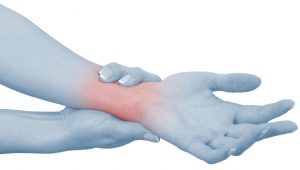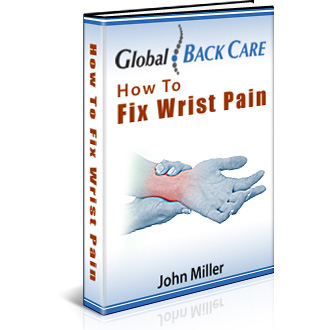
How To Fix Wrist Pain Naturally
Are You Interested to Fix Wrist Pain?
- Do you have trouble typing, unscrewing lids and lifting light weights?
- Have you had to start picking things up with your other hand?
- Is icing, heating and rubbing failing to relieve your pain?
- Do your wrists hurt so much that you can no longer type without wincing?
- Do your hands tingle after just 10 minutes at the computer?
- Can you no longer sleep at night because the pain is so unbearable?
- Are you relying on anti-inflammatory drugs and Panadol Forte to put up with the pain?
- Is the best the OH&S staff has done is give you a gel pad?
- Has your doctor recommended surgery or has your physio locked you into an expensive and ongoing program that involves rubbing, heating and vibrating?
Here’s How To Relieve Wrist Pain Naturally
First, find out what’s causing the problem.
Second, embark on a systematic strength and flexibility training program that gets your body back in alignment and strengthens the muscles in your trunk, shoulders, arms, and fingers so they can do the work they were designed to do.
Third, treat wrist pain as a symptom of a range of dysfunctions, which may be caused by weak and tight muscles in your trunk, shoulders, arms, and hands. There’s a fair chance that once those muscles have been retrained to the job they’re meant to do, your wrist pain will have vanished.
That it should come to this!
The species designed to draw water, chop wood and climb trees can no longer tap a keyboard or push a mouse without coming down with painful wrists.
What’s the cause of wrist pain?
Wrist pain comes at the end of a long chain of dysfunction.
This is because the wrist is part of a complex set of levers, and unless the whole musculoskeletal ecosystem is working properly, you can end up with upper back, shoulder, arm, and hand dysfunction all in one go. One of the symptoms is wrist pain.
If the system is not in good working order, it’s pretty much a potluck decision as to which part will go first.
Just focusing on what’s happening at the spot where it’s painful may miss the point.
Wrist pain comes in a range of forms. One of the most common expressions used to describe it is repetitive strain injury, sometimes known as occupational overuse syndrome (OOS). The word ‘syndrome’ is medically pronounced as ‘We don’t know what the cause of the problem is.’
I suspect that the problem is not so much overuse as underuse. Without a program to strengthen and loosen muscles in your body generally and your shoulders, arms, and hands, you’re setting yourself up for wrist pain.
To put it bluntly, your body is neither in correct alignment nor strong enough to do the job you persistently do. And when you think about it, many jobs where people come down with wrist pain don’t look particularly strenuous. People are breaking down doing jobs that ordinary, healthy people take in their stride.
When it comes to wrist pain, treat the body as a musculoskeletal ecosystem.
Wrist pain is as much a general problem belonging to the whole musculoskeletal ecosystem as a specific wrist problem.
You’ve heard of the song, ‘The hip bone’s connected to the backbone…’ It’s true; a pelvis that’s out of alignment will affect shoulders, arms and wrists.
If your pelvis and shoulders get ‘locked up’ because of how you sit at your desk, you dramatically increase the risk of wrist dysfunction.
When you look around an office and see people sitting with their backs in a ‘C’ shape and not the normal ‘S’ shape, you know that back, shoulder, neck, arm, wrist and hand dysfunction are in the making.
Even if your sitting posture is good, imagine how much strain you put on your arms and wrists by having them outstretched in front of you for much of the day. Imagine the stress placed on shoulders and arms.
What appears to be an easy job requires a considerable amount of strength to hold this position without the shoulders and wrists succumbing to dysfunction.
Typing is very different from writing. When people write, the wrist of the hand holding the pen rests on the desk, and the upper body is supported by the other arm or elbow resting on the desk.
Rarely, if ever, is it demanded of office workers that they take a few minutes out of their day to improve their strength and flexibility.
Typing has changed the mechanics of written communication. You must be much more robust to perform the typing action, especially in the trunk, shoulder, arm, and hand muscles. Most people don’t have a strength training program to prepare for this task.
You must have optimal flexibility in the muscles designed to allow you to adopt the perfect sitting posture.
The sit-down job is deceptively comfortable. It looks easy. Who would ever think they needed a muscle training program to sit in a chair without coming down with sore wrists? Well, you do.
The value of therapy
Most therapies focus on the symptom (the pain) rather than the cause. They also tend to focus on the spot where it hurts and not on the total musculoskeletal ecosystem. There’s a lot of rubbing, heating, vibrating, and doping but not a lot of strength and flexibility exercises.
Without a general and specific conditioning program, recovery will be long, slow, tortuous, frustrating and expensive.
If you think you can cure your disability without a muscle-building and loosening program, you’ve got another thing coming.
Whilst you’re being rubbed, heated, vibrated and doped, you’re not getting more robust or more flexible. Your condition is getting worse. You’re being palliated, not fixed.
Wrist pain is not caused by the absence of rubbing, heating, vibrating or anti-inflammatory tablets.
The great tragedy is most people leave their rehab program to therapists and fail to do anything for themselves. It’s an almost intuitive reaction to any pain we want someone to fix for us. Once the therapy starts, our minds divert from what we need to do for ourselves.
Having said that, if you adopt the elite athlete approach to rehab and be prepared to spend time on a rehab program, adding a wide range of modalities will dramatically speed up the rehab process.
Always remember, though, that improving strength and flexibility is a long-term proposition. You’re looking at months, not weeks.
That being the case, you need to get cracking NOW!
The wrist pain rehab formula
The key to restoring poor wrist function to good is improving the strength and flexibility of all the major muscle groups of your body, particularly your shoulders, arms and wrists.
In a nutshell, the rehab solution involves
- Getting your body back into better alignment
- Improving your overall body strength and flexibility
- In particular, improving the strength and flexibility of your upper body, shoulders, arms and wrists
- Adopting the perfect posture while sitting in front of a computer – back of the chair upright and pressing your back and abdomen into the desk.
The Fix Wrist Pain program will improve your strength and flexibility and restore poor trunk, shoulder, arm, wrist and hand function to good.
Fix Wrist Pain contains
- an outline of some of the most common causes of wrist pain. It will provide you with insight, awareness and understanding of what’s causing your pain.
- Some of the basic principles that underpin good function
- descriptions of some of the key exercises you need to do to get your body back into better alignment and get your arms, wrists and hands back into good shape.
- Information about the benefits of a wide range of therapies may help speed up the rehab process.
Best of all, the Fix Wrist Pain program will not cost you a fortune, just $7us, about the cost of a cup of coffee and a newspaper.
In a nutshell, here’s what I will do for you.
Get your wrists back into a pain-free state.
Save you a fortune. From now on, you’re the therapist.
Relieve your wrist pain.
The Fix Wrist Pain ebook
$7us
Here’s the link to our guarantee.
The Fix Wrist Pain ebook is 100% downloadable. IMMEDIATELY!
The program is accessible online in PDF format. It will appear on your screen in minutes.
Feel free to get in touch with me using the contact form.
Here’s to your good health.
John Miller


